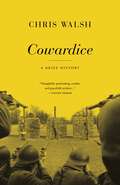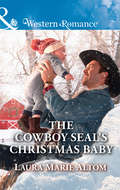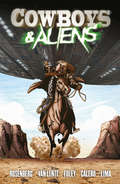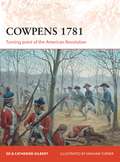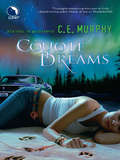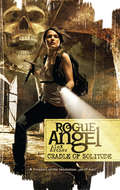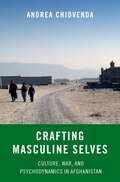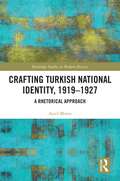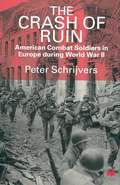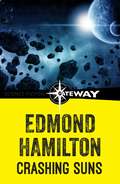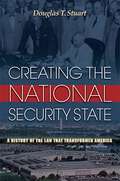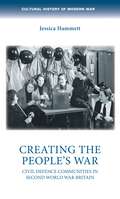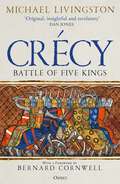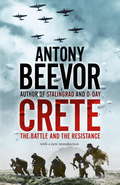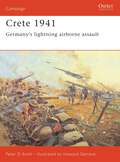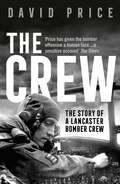- Table View
- List View
Cowardice: A Brief History (PDF)
by Chris WalshCoward. It's a grave insult, likely to provoke anger, shame, even violence. But what exactly is cowardice? When terrorists are called cowards, does it mean the same as when the term is applied to soldiers? And what, if anything, does cowardice have to do with the rest of us? Bringing together sources from court-martial cases to literary and film classics such as Dante's Inferno, The Red Badge of Courage, and The Thin Red Line, Cowardice recounts the great harm that both cowards and the fear of seeming cowardly have done, and traces the idea of cowardice’s power to its evolutionary roots. But Chris Walsh also shows that this power has faded, most dramatically on the battlefield. Misconduct that earlier might have been punished as cowardice has more recently often been treated medically, as an adverse reaction to trauma, and Walsh explores a parallel therapeutic shift that reaches beyond war, into the realms of politics, crime, philosophy, religion, and love.Yet, as Walsh indicates, the therapeutic has not altogether triumphed—contempt for cowardice endures, and he argues that such contempt can be a good thing. Courage attracts much more of our attention, but rigorously understanding cowardice may be more morally useful, for it requires us to think critically about our duties and our fears, and it helps us to act ethically when fear and duty conflict.Richly illustrated and filled with fascinating stories and insights, Cowardice is the first sustained analysis of a neglected but profound and pervasive feature of human experience.
The Cowboy Seal's Christmas Baby: The Cowboy Seal's Jingle Bell Baby The Surgeon's Christmas Baby (Cowboy SEALs #5)
by Laura Marie AltomHIS UNEXPECTED CHRISTMAS SURPRISE…
Cowboys and Aliens
by Scott Mitchell RosenbergArizona. 1873. The ultimate showdown between cowboys and Indians is interrupted… by an alien invasion.
Cowpens 1781: Turning point of the American Revolution (Campaign #283)
by Ed Gilbert Catherine GilbertThis is a blistering account of the battle of Cowpens, a short, sharp conflict which marked a crucial turning point in the American Revolution. With Lt. Col. Banastre Tarleton and the British troops in hot pursuit, Daniel Morgan, leading a small force of 700 Continentals and militia, chose the Cowpens as the battlefield in which to make a stand. The two forces clashed for barely more than 45 minutes, yet this brief battle shaped the outcome of the War in the South and decisively influenced the conflict as a whole. The authors provide a shrewd analysis of what was perhaps the finest tactical performance of the entire war. Bird's-eye views, vivid illustrations and detailed maps illuminate the dynamism of this clash between two of the most famous commanders of the War of Independence.
Cowpens 1781: Turning point of the American Revolution (Campaign)
by Graham Turner Ed Gilbert Catherine GilbertThis is a blistering account of the battle of Cowpens, a short, sharp conflict which marked a crucial turning point in the American Revolution. With Lt. Col. Banastre Tarleton and the British troops in hot pursuit, Daniel Morgan, leading a small force of 700 Continentals and militia, chose the Cowpens as the battlefield in which to make a stand. The two forces clashed for barely more than 45 minutes, yet this brief battle shaped the outcome of the War in the South and decisively influenced the conflict as a whole. The authors provide a shrewd analysis of what was perhaps the finest tactical performance of the entire war. Bird's-eye views, vivid illustrations and detailed maps illuminate the dynamism of this clash between two of the most famous commanders of the War of Independence.
Coyote Dreams (The Walker Papers #4)
by C.E. MurphyInstead of powerful forces storming Seattle, a more insidious invasion is happening.
Cradle Of Solitude (Gold Eagle Rogue Angel Ser.)
by Alex ArcherOne mystery could change the fate of a nation… The skeletal remains of a confederate soldier, hidden deep within the Paris Catacombs. The legend of a long-lost Confederate treasure. An aged scrap of paper that reads simply, Berceau de solitude–Cradle of Solitude.
Crafting Masculine Selves: Culture, War, and Psychodynamics in Afghanistan
by Andrea ChiovendaAgainst the backdrop of four decades of continuous conflict in Afghanistan, the Pashtun male protagonists of this book carry out their daily effort to internally negotiate, adjust (if at all), and respond to the very strict cultural norms and rules of masculinity that their androcentric social environment enjoins on them. Yet, in a widespread context of war, displacement, relocation, and social violence, cultural expectations and stringent tenets on how to comport oneself as a "real man" have a profound impact on the psychological equilibrium and emotional dynamics of these individuals. This book is a close investigation into these private and at times contradictory aspects of subjectivity. Stemming from five years of research in a southeastern province of Afghanistan, it presents a long-term, psychodynamic engagement with a select group of male Pashtun individuals, which results in a multilayered dive not only into their inner lives, but also into the cultural and social environment in which they live and develop. Behind the screen of what often seems like outward conformity, Andrea Chiovenda is able to point to areas of strong inner conflict, ambivalence, and rebellion, which in turn will serve as the seeds for cultural and social change. These dynamics play out in a setting in which what was considered legitimate and justifiable violence on the battlefield has now spilled over into everyday life, even among non-combatants.
Crafting Masculine Selves: Culture, War, and Psychodynamics in Afghanistan
by Andrea ChiovendaAgainst the backdrop of four decades of continuous conflict in Afghanistan, the Pashtun male protagonists of this book carry out their daily effort to internally negotiate, adjust (if at all), and respond to the very strict cultural norms and rules of masculinity that their androcentric social environment enjoins on them. Yet, in a widespread context of war, displacement, relocation, and social violence, cultural expectations and stringent tenets on how to comport oneself as a "real man" have a profound impact on the psychological equilibrium and emotional dynamics of these individuals. This book is a close investigation into these private and at times contradictory aspects of subjectivity. Stemming from five years of research in a southeastern province of Afghanistan, it presents a long-term, psychodynamic engagement with a select group of male Pashtun individuals, which results in a multilayered dive not only into their inner lives, but also into the cultural and social environment in which they live and develop. Behind the screen of what often seems like outward conformity, Andrea Chiovenda is able to point to areas of strong inner conflict, ambivalence, and rebellion, which in turn will serve as the seeds for cultural and social change. These dynamics play out in a setting in which what was considered legitimate and justifiable violence on the battlefield has now spilled over into everyday life, even among non-combatants.
Crafting Turkish National Identity, 1919-1927: A Rhetorical Approach (Routledge Studies in Modern History)
by Aysel MorinExamining Mustafa Kemal Atatürk’s Büyük Nutuk (The Great Public Address), this book identifies the five founding political myths of Turkey: the First Duty, the Internal Enemy, the Encirclement, the Ancestor, and Modernity. Offering a comprehensive rhetorical analysis of Nutuk in its entirety, the book reveals how Atatürk crafted these myths, traces their discursive roots back to the Orkhon Inscriptions, epic tales, and ancient stories of Turkish culture, and critiques their long-term effects on Turkish political culture. In so doing, it advances the argument that these myths have become permanent fixtures of Turkish political discourse since the establishment of Turkey and have been used by both supporters and detractors of Atatürk. Providing examples of how past and present leaders, including Recep Tayyip Erdoğan, a vocal critic of Atatürk, have deployed these myths in their discourses, the book offers an entirely new way to read and understand Turkish political culture and contributes to the heated debate on Kemalism by responding to the need to go back to the original sources – his own speeches and statements – to understand him. Contributing to emerging discourse-based approaches, this book is ideal for scholars and students of Turkish Studies, History, Nationalism Studies, Political Science, Rhetorical Studies, and International Studies.
Crafting Turkish National Identity, 1919-1927: A Rhetorical Approach (Routledge Studies in Modern History)
by Aysel MorinExamining Mustafa Kemal Atatürk’s Büyük Nutuk (The Great Public Address), this book identifies the five founding political myths of Turkey: the First Duty, the Internal Enemy, the Encirclement, the Ancestor, and Modernity. Offering a comprehensive rhetorical analysis of Nutuk in its entirety, the book reveals how Atatürk crafted these myths, traces their discursive roots back to the Orkhon Inscriptions, epic tales, and ancient stories of Turkish culture, and critiques their long-term effects on Turkish political culture. In so doing, it advances the argument that these myths have become permanent fixtures of Turkish political discourse since the establishment of Turkey and have been used by both supporters and detractors of Atatürk. Providing examples of how past and present leaders, including Recep Tayyip Erdoğan, a vocal critic of Atatürk, have deployed these myths in their discourses, the book offers an entirely new way to read and understand Turkish political culture and contributes to the heated debate on Kemalism by responding to the need to go back to the original sources – his own speeches and statements – to understand him. Contributing to emerging discourse-based approaches, this book is ideal for scholars and students of Turkish Studies, History, Nationalism Studies, Political Science, Rhetorical Studies, and International Studies.
The Crash of Ruin: American Combat Soldiers in Europe during World War II
by Peter SchrijversThis book offers a compelling account of how America's combat soldiers experienced Europe during World War II. It paints a vivid picture of the GIs' struggles with its natural surroundings, their confrontations with its soldiers, their encounters with its civilians, and their reactions to uncovering the holocaust. The book shows how these harrowing experiences convinced the American soldiers that Europe's collapse was not just the result of the war, but also of the Old World's deep-seated political cynicism, economic stagnation, and cultural decadence.
Crashing Suns
by Edmond HamiltonFrom mighty Canopus, capital of the Federated Stars, to the outer fringes of our great galaxy, the Interstellar Patrol was on the watch. Rogue suns, marauding alien intelligences, man-made comets driven by their makers for the conquest of unsuspecting worlds, diabolical conspiracies hatched in the depths of unmapped nebulae - it was the business of the Patrol's mighty spaceships to guard against such cosmic dangers.Crashing Suns is the epic account of this future space legion, where volunteers from a thousand worlds man the mighty starcraft of a hundred thousand years to come.
Craving Her Ex-Army Doc: Craving Her Ex-army Doc The Nurse Who Stole His Heart Discovering Dr. Riley (Sealed by a Valentine's Kiss #2)
by Amy RuttanFlirting with danger…
Creating the National Security State: A History of the Law That Transformed America
by Douglas StuartFor the last sixty years, American foreign and defense policymaking has been dominated by a network of institutions created by one piece of legislation--the 1947 National Security Act. This is the definitive study of the intense political and bureaucratic struggles that surrounded the passage and initial implementation of the law. Focusing on the critical years from 1937 to 1960, Douglas Stuart shows how disputes over the lessons of Pearl Harbor and World War II informed the debates that culminated in the legislation, and how the new national security agencies were subsequently transformed by battles over missions, budgets, and influence during the early cold war. Stuart provides an in-depth account of the fight over Truman's plan for unification of the armed services, demonstrating how this dispute colored debates about institutional reform. He traces the rise of the Office of the Secretary of Defense, the transformation of the CIA, and the institutionalization of the National Security Council. He also illustrates how the development of this network of national security institutions resulted in the progressive marginalization of the State Department. Stuart concludes with some insights that will be of value to anyone interested in the current debate over institutional reform.
Creating the National Security State: A History of the Law That Transformed America (PDF)
by Douglas T. StuartFor the last sixty years, American foreign and defense policymaking has been dominated by a network of institutions created by one piece of legislation--the 1947 National Security Act. This is the definitive study of the intense political and bureaucratic struggles that surrounded the passage and initial implementation of the law. Focusing on the critical years from 1937 to 1960, Douglas Stuart shows how disputes over the lessons of Pearl Harbor and World War II informed the debates that culminated in the legislation, and how the new national security agencies were subsequently transformed by battles over missions, budgets, and influence during the early cold war. Stuart provides an in-depth account of the fight over Truman's plan for unification of the armed services, demonstrating how this dispute colored debates about institutional reform. He traces the rise of the Office of the Secretary of Defense, the transformation of the CIA, and the institutionalization of the National Security Council. He also illustrates how the development of this network of national security institutions resulted in the progressive marginalization of the State Department. Stuart concludes with some insights that will be of value to anyone interested in the current debate over institutional reform.
Creating the people’s war: Civil defence communities in Second World War Britain (Cultural History of Modern War)
by Jessica HammettWhy has the ‘people’s war’ been such a durable and attractive myth? Creating the people’s war examines how civil defence personnel engaged with this narrative during the war and in the following decades to answer this question. Civil defence was the most significant voluntary organisation of the Second World War, involving millions of men and women of every class, generation and locality in Britain. This book shows how local communities of civil defence personnel co-developed narratives about the value of their work which challenged hierarchies of war service. In their social groups volunteers wrote themselves into the ‘people’s war’ and invested it with meaning, creating national identity from the bottom up. Community was both central to these representations and vital for their production.
Creating the people’s war: Civil defence communities in Second World War Britain (Cultural History of Modern War)
by Jessica HammettWhy has the ‘people’s war’ been such a durable and attractive myth? Creating the people’s war examines how civil defence personnel engaged with this narrative during the war and in the following decades to answer this question. Civil defence was the most significant voluntary organisation of the Second World War, involving millions of men and women of every class, generation and locality in Britain. This book shows how local communities of civil defence personnel co-developed narratives about the value of their work which challenged hierarchies of war service. In their social groups volunteers wrote themselves into the ‘people’s war’ and invested it with meaning, creating national identity from the bottom up. Community was both central to these representations and vital for their production.
Crécy: Battle of Five Kings
by Michael Livingston'Like Crécy itself, this book is a triumph and the tale it tells gives an old story new life.'BERNARD CORNWELL, bestselling author of The Last Kingdom seriesA groundbreaking new study of the battle of Crécy, in which the outnumbered English under King Edward III won a decisive victory over the French and changed the course of the Hundred Years War. The battle of Crécy in 1346 is one of the most famous and widely studied military engagements in history. The repercussions of this battle were felt for hundreds of years, and the exploits of those fighting reached the status of legend. Yet cutting-edge research has shown that nearly everything that has been written about this dramatic event may be wrong.In this new study, Michael Livingston reveals how modern scholars have used archived manuscripts, satellite technologies and traditional fieldwork to help unlock what was arguably the battle's greatest secret: the location of the now quiet fields where so many thousands died. Crécy: Battle of Five Kings is a story of past and present. It is a new history of one of the most important battles of the Middle Ages: a compelling narrative account of the battle of Crécy that still adheres to the highest scholarly standards in its detail. It is also an account that incorporates the most cutting-edge revelations and the personal story of how those discoveries were made.
Crécy: Battle of Five Kings
by Michael Livingston'Like Crécy itself, this book is a triumph and the tale it tells gives an old story new life.'BERNARD CORNWELL, bestselling author of The Last Kingdom seriesA groundbreaking new study of the battle of Crécy, in which the outnumbered English under King Edward III won a decisive victory over the French and changed the course of the Hundred Years War. The battle of Crécy in 1346 is one of the most famous and widely studied military engagements in history. The repercussions of this battle were felt for hundreds of years, and the exploits of those fighting reached the status of legend. Yet cutting-edge research has shown that nearly everything that has been written about this dramatic event may be wrong.In this new study, Michael Livingston reveals how modern scholars have used archived manuscripts, satellite technologies and traditional fieldwork to help unlock what was arguably the battle's greatest secret: the location of the now quiet fields where so many thousands died. Crécy: Battle of Five Kings is a story of past and present. It is a new history of one of the most important battles of the Middle Ages: a compelling narrative account of the battle of Crécy that still adheres to the highest scholarly standards in its detail. It is also an account that incorporates the most cutting-edge revelations and the personal story of how those discoveries were made.
Crete: The Battle and the Resistance (History And Warfare Ser.)
by Antony BeevorAcclaimed historian and best-selling author Antony Beevor vividly brings to life the epic struggles that took place in Second World War Crete - reissued with a new introduction.'The best book we have got on Crete' ObserverThe Germans expected their airborne attack on Crete in 1941 - a unique event in the history of warfare - to be a textbook victory based on tactical surprise. They had no idea that the British, using Ultra intercepts, knew their plans and had laid a carefully-planned trap. It should have been the first German defeat of the war, but a fatal misunderstanding turned the battle round. Nor did the conflict end there. Ferocious Cretan freedom fighters mounted a heroic resistance, aided by a dramatic cast of British officers from Special Operations Executive.
Crete 1941: Germany’s lightning airborne assault (Campaign)
by Howard Gerrard Peter AntillOperation Mercury, the German airborne assault on the island of Crete in May 1941, was the first strategic use of airborne forces in history. The assault began on 20 May, with landings near the island's key airports, and reinforcements the next day allowed the German forces to capture one end of the runway at Maleme. By 24 May, the Germans were being reinforced by air on a huge scale and on 1 June Crete surrendered. This book describes how desperately close the battle had been and explains how German losses so shocked the Führer that he never again authorised a major airborne operation.
Crete 1941: Germany’s lightning airborne assault (Campaign #147)
by Howard Gerrard Peter AntillOperation Mercury, the German airborne assault on the island of Crete in May 1941, was the first strategic use of airborne forces in history. The assault began on 20 May, with landings near the island's key airports, and reinforcements the next day allowed the German forces to capture one end of the runway at Maleme. By 24 May, the Germans were being reinforced by air on a huge scale and on 1 June Crete surrendered. This book describes how desperately close the battle had been and explains how German losses so shocked the Führer that he never again authorised a major airborne operation.
The Crew: The Story of a Lancaster Bomber Crew
by David PriceA moving tribute to the sacrifice and bravery of the fliers of RAF Bomber Command. ****************************** The Crew, based on interviews with Ken Cook, the crew's sole surviving member, recounts the wartime exploits of the members of an Avro Lancaster crew between 1942 and the war's end. Gloucestershire-born bomb aimer Ken Cook, hard-bitten Australian pilot Jim Comans, Navigator Don Bowes, Upper Gunner George Widdis, Tail Gunner 'Jock' Bolland, Flight Engineer Ken Randle and Radio Operator Roy Woollford were seven ordinary young men living in extraordinary times, risking their lives in freedom's cause in the dark skies above Hitler's Reich. From their earliest beginnings – in places as far apart as a Cotswold village and the suburbs of Sydney – through the adventure of training in North America and the dread and danger of the forty-five bombing raids they flew with 97 Squadron, David Price describes the crew's wartime experiences with human sympathy allied to a secure technical understanding of one of the RAF's most iconic aircraft. The drama and anxiety of individual missions – to Kassel, Munich and Augsburg as well as Berlin – is evoked with thrilling immediacy; while the military events and strategic decisions that drove the RAF's area bombing campaign against Nazi Germany are interwoven deftly with the narrative of the crew's operational careers. ****************************** Reviews: 'A sensitive account of the bomber's life... Price has given the bomber offensive a human face. This book [...] has a heart and soul' The Times. 'A fascinating and fast-paced account of the exploits of an Avro Lancaster bomber crew from 97 Squadron RAF' The Herald. 'A remarkable insight into the bravery, determination and skill of British Bomber Command crews during WWII' Waterstones.
Cricket and community in England: 1800 to the present day (PDF)
by Peter DaviesAvailable in paperback for the first time, Cricket and Community in England: 1800 to the Present Day is a path-breaking enquiry into the social history of the summer game. It is written by two specialist cricket historians and based on extensive primary research. It traces the history of the sport at grassroots level from its origins right up to the present day. It will appeal to the cricket historian and the general sports enthusiast alike. The book has two main goals: to provide readers with an accessible introduction to the history of grassroots cricket in England and to supply a clear overview of the different phases of this history. The structure of book is chronological but also thematic. The six chapters look at such issues as early cricket, the origins of clubs, competition, the two world wars, multiculturalism and cricket in the twenty-first century.
